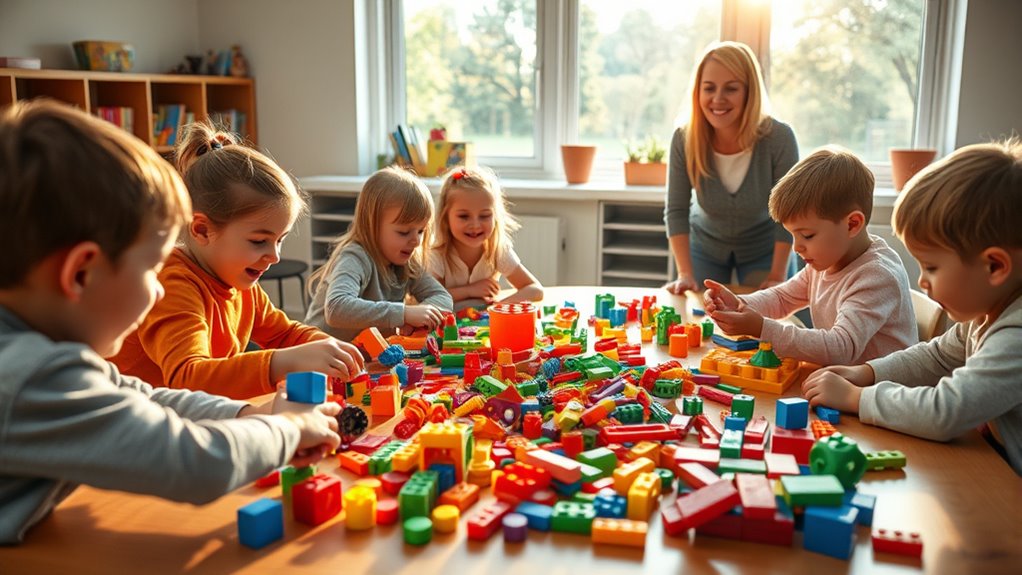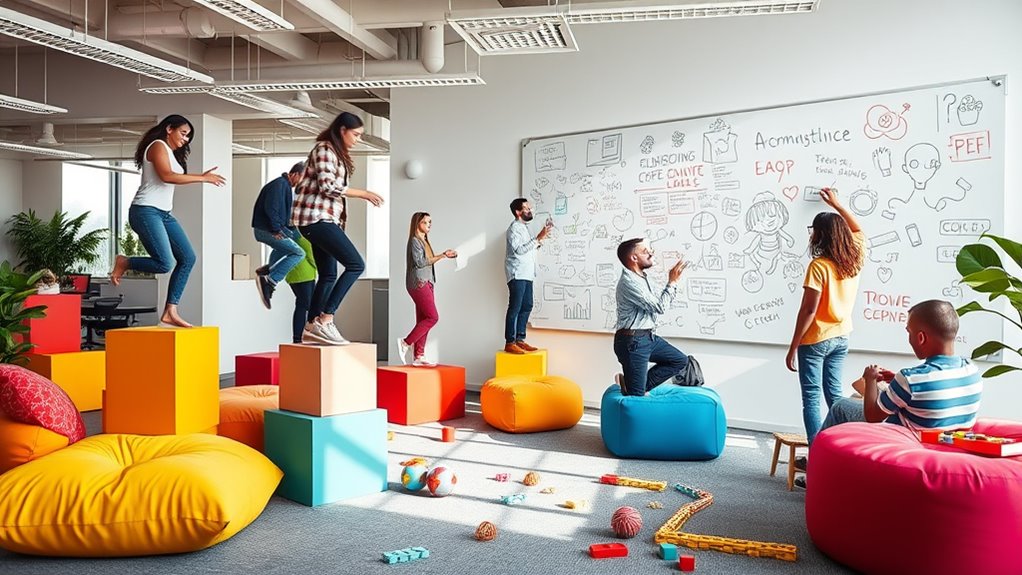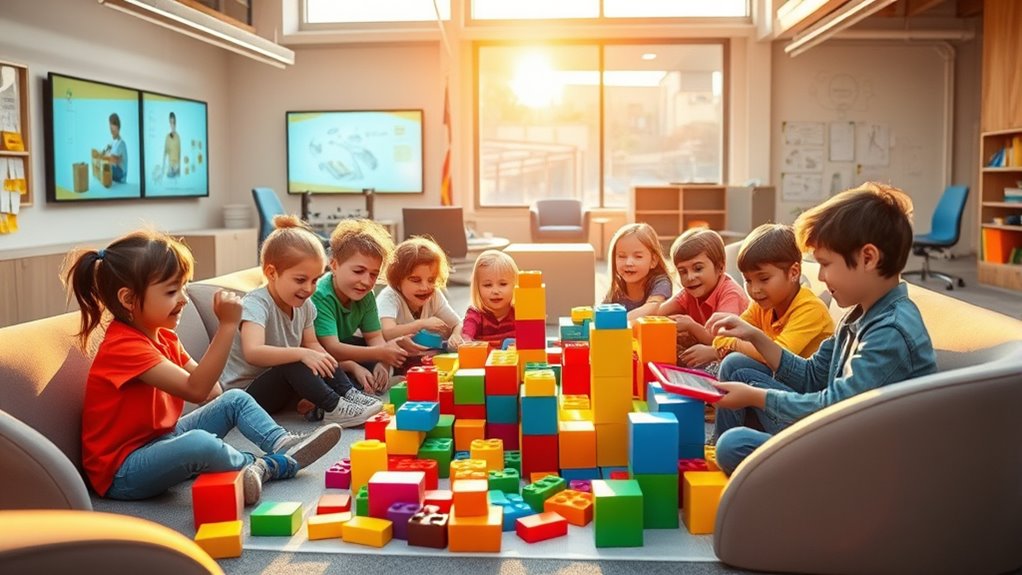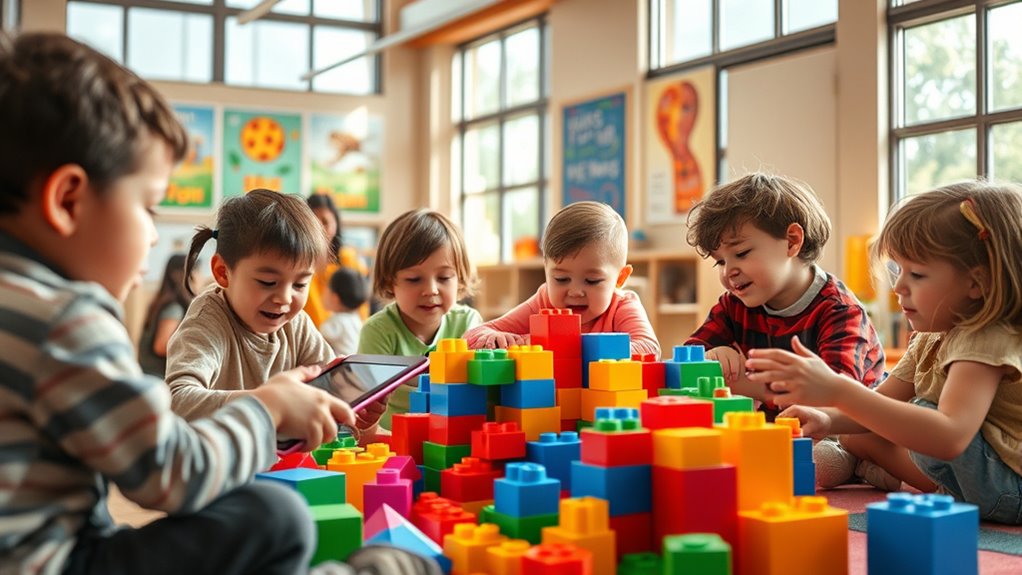Engaging in play boosts your brain’s neural paths for imagination and problem-solving, making you more creative and adaptable. Play encourages risk-taking, resilience, and a mindset open to experimentation, which fuels innovation. Unstructured play environments foster spontaneous ideas and collaboration, breaking routine and sparking fresh perspectives. Incorporating playful strategies and environments can transform how you approach challenges. To unleash the full potential of play for innovation, there’s much more to explore that can truly elevate your creative approach.
Key Takeaways
- Play stimulates neural pathways that enhance imagination, problem-solving, and mental flexibility, fostering innovative thinking.
- Engaging in playful activities encourages risk-taking and experimentation, critical for creative breakthroughs.
- Unstructured play environments promote spontaneous collaboration and fresh perspectives, driving innovation.
- Incorporating playful techniques and aesthetic elements in workspaces nurtures a culture of creativity.
- Case studies show that playful exploration leads to breakthrough innovations in industries like gaming, tech, and entertainment.
The Science Behind Play and Creativity

Have you ever wondered how play sparks creativity in the brain? Neuroscience insights reveal that engaging in playful activities stimulates neural pathways linked to imagination and problem-solving. When you play, your brain forms new connections, enhancing flexibility and innovative thinking. Developmental psychology shows that play helps children develop critical cognitive skills by encouraging exploration and experimentation. During play, the brain’s reward system activates, reinforcing curiosity and motivation. This process boosts your ability to think outside the box and approach challenges creatively. As you experiment with different scenarios and ideas in play, you strengthen neural circuits responsible for originality. Additionally, neural plasticity can be cultivated by anyone, regardless of skill level, further supporting the development of innovative thinking. Ultimately, neuroscience and developmental psychology confirm that play isn’t just fun—it’s a essential driver of creative development in all ages.
Play as a Catalyst for Problem-Solving Skills

When you engage in play, you boost your creativity and become more adaptable to new challenges. Play encourages you to take risks without fear of failure, fostering a problem-solving mindset. This mindset helps you approach obstacles with flexibility and confidence. Engaging in activities like creating candy art can further enhance your innovative thinking skills. Additionally, practicing safe raw food handling techniques can support a mindful and health-conscious approach to experimentation.
Enhances Creativity and Flexibility
How does play spark your creativity and boost your flexibility in solving problems? By cultivating playful habits, you engage your mind in new ways, encouraging innovative thinking. Playful habits help you approach challenges with a fresh perspective, fostering creative solutions. Play also serves as adaptability training, enabling you to adapt quickly when plans shift or obstacles arise. When you incorporate play into your routine, you strengthen your ability to think outside the box and pivot effortlessly. This enhanced flexibility makes you more open to exploring unconventional ideas and experimenting with different approaches. Additionally, incorporating auditory processing techniques can further enhance your problem-solving skills by improving your listening and comprehension abilities. Understanding the importance of individual evidence in investigations can also inspire creative strategies for problem-solving in various contexts. Ultimately, play nurtures your creative capacity, allowing you to see opportunities where others see only limitations. It’s a crucial tool for developing the mental agility essential for innovative problem-solving.
Promotes Risk-Taking Attitudes
Engaging in playful activities naturally encourages you to take risks without fear of failure. Play builds your risk appetite by creating a safe environment where experimentation is welcomed. As you explore new ideas through play, you develop boldness encouragement, making you more willing to face uncertainties. This mindset transfer helps you approach challenges with confidence, fostering innovative problem-solving skills. Play removes the fear of judgment, allowing you to experiment with unconventional solutions. Over time, this risk-taking attitude becomes ingrained, enabling you to pursue ambitious projects and think outside the box. By promoting boldness, play enhances your ability to navigate ambiguity and embrace the unknown—crucial traits for driving innovation and continuous improvement. Additionally, cultivating a safe space for vulnerability during play can further reinforce the development of resilient and adaptable problem-solving capabilities. Creating environments that mimic shallow waters allows individuals to practice maneuverability and confidence in unfamiliar situations, strengthening their capacity for creative solutions.
Unstructured Play and Innovation in the Workplace

Could unstructured play truly spark innovation in the workplace? Absolutely. When you embrace unstructured play, you open the door to playful collaboration and spontaneous inspiration. This environment encourages team members to experiment freely, fostering new ideas without pressure. Imagine a space where:
- Teams gather informally around a whiteboard, bouncing ideas off each other spontaneously.
- Employees participate in playful activities that break routine, sparking fresh perspectives.
- Casual interactions lead to unexpected insights, fueling innovation.
- Incorporating creative thinking techniques can further enhance the benefits of unstructured play, leading to more innovative outcomes. Additionally, providing comfortable and supportive environments can make participants feel more at ease, promoting uninhibited creativity.
Creative Exercises That Spark New Ideas

You can open fresh ideas through imaginative brainstorming techniques that challenge your usual thinking patterns. Playful problem-solving strategies encourage you to approach obstacles with curiosity and creativity. These exercises make innovation feel natural and enjoyable, fueling your ability to generate new solutions. Incorporating flavorful and creative recipes, such as easy homemade flautas, can also stimulate your culinary imagination and inspire innovative ideas in other areas. Engaging in emotional support activities can help foster a positive mindset, making it easier to think creatively and embrace new concepts.
Imaginative Brainstorming Techniques
Imaginative brainstorming techniques serve as powerful tools to open fresh ideas and foster creative thinking. They encourage you to break free from routine and explore new perspectives. For example:
- Engage in collaborative ideation sessions, where bouncing ideas off others sparks innovation and diverse viewpoints.
- Practice spontaneous doodling, letting your hand draw freely to unlock subconscious connections and novel concepts.
- Use visual prompts or storyboarding to stimulate your imagination, transforming abstract ideas into tangible visuals.
- Incorporate market analysis into your creative exercises to gain insights into emerging trends and enhance your innovative potential.
These techniques make brainstorming more dynamic and playful, helping you tap into your creative potential. By incorporating playful elements like spontaneous doodling and teamwork, you create an environment where innovative ideas flourish naturally. The key is to stay open and enjoy the process.
Playful Problem-Solving Strategies
When approaching complex problems, playful problem-solving strategies can liberate fresh ideas and innovative solutions. Engaging in playful storytelling allows you to reframe challenges creatively, opening new perspectives. By weaving narratives around issues, you tap into your imagination and uncover unexpected connections. Improvisational techniques, such as spontaneous role-playing or quick-fire idea generation, break mental ruts and foster flexibility. These exercises encourage you to experiment without fear of failure, boosting your adaptive thinking. Incorporating play into your problem-solving routine transforms difficult tasks into engaging challenges, making innovation feel natural. Whether through storytelling or improvisation, these playful methods activate your creative instincts, helping you discover unique solutions that might otherwise remain hidden. Additionally, leveraging TikTok’s content creation tools and trends can inspire new ideas and approaches in your problem-solving process. Recognizing the importance of creativity in innovation helps you understand how playful exercises stimulate your mind to generate fresh, effective ideas.
Case Studies of Play-Driven Breakthroughs

Throughout history, many groundbreaking innovations have emerged from playful experimentation rather than linear research. These case studies highlight how playful leadership and dynamic innovation ecosystems foster breakthroughs. For instance:
- The development of the Nintendo Wii, where playful testing led to a new gaming experience, emphasizing fun over traditional graphics.
- Google’s 20% rule, encouraging employees to explore passion projects, sparking products like Gmail and AdSense.
- Pixar’s creative process, blending play and storytelling to produce revolutionary animated films.
Playful testing often involves creative problem-solving techniques that lead to unexpected solutions and innovations.
Incorporating Play Into Learning and Development

Incorporating play into learning and development transforms traditional training methods into engaging, hands-on experiences that enhance retention and creativity. By integrating learning games, you make complex concepts more accessible and enjoyable, encouraging active participation. These games foster collaboration and critical thinking, making learning dynamic rather than passive. Additionally, playful assessments provide immediate feedback, helping you identify strengths and areas for improvement without stress. When you embed play into training, you create an environment where experimentation and curiosity thrive. This approach not only boosts motivation but also helps solidify knowledge through fun, memorable activities. Incorporating mindfulness practices in training can further reduce stress and improve focus, enhancing overall learning outcomes. Understanding the financial impact of entertainment industries like WWE Raw and the earnings of top female artists can also inspire innovative thinking in training programs.
Practical Strategies to Foster Playful Thinking

To effectively foster playful thinking, start by creating an environment that encourages curiosity and experimentation. Embrace playful leadership by modeling openness and flexibility, inspiring others to think creatively. Promote spontaneous collaboration by setting up spaces and opportunities where team members can exchange ideas freely. Here are three practical strategies: 1. Schedule unstructured brainstorming sessions that focus on open-ended questions and playful challenges. 2. Incorporate playful tools like game-based problem-solving or role-playing activities to stimulate innovative thinking. 3. Recognize and reward spontaneous ideas and collaboration, reinforcing the value of playful engagement. Additionally, integrating aesthetic elements like colorful and textured home decor items can create a vibrant atmosphere that sparks creativity.
Frequently Asked Questions
How Does Play Influence Long-Term Innovation in Organizations?
Play sparks long-term innovation by fostering playful leadership that encourages creativity and risk-taking. When you create innovation ecosystems that embrace playful interactions, you build a culture where new ideas flourish. You empower your teams to experiment, learn from failures, and think outside the box. This ongoing cycle of playful engagement helps sustain innovation over time, making your organization adaptable, forward-thinking, and resilient in a constantly changing environment.
Are There Specific Types of Play That Most Effectively Boost Creativity?
You might find that engaging in creative exercises and imaginative activities most effectively boosts your creativity. These types of play encourage you to think outside the box, challenge assumptions, and explore new ideas freely. By actively participating in such playful approaches, you stimulate your brain’s innovative capacity, making it easier to develop fresh solutions and insights. Incorporating these activities into your routine can markedly enhance your creative potential and problem-solving skills.
Can Adults Effectively Incorporate Play Into Their Daily Routines?
Think adults can’t play? Think again. You can effectively incorporate play into your daily routines by blending mindful reflection with playful activities. Schedule short breaks for creative doodling, quick games, or spontaneous dance. These playful routines boost your mood and spark innovation. By intentionally adding fun moments, you create a balance that nurtures your mind and fuels your creativity, proving that play isn’t just for kids—it’s essential for grown-ups too.
What Are the Psychological Barriers to Adopting Play in Professional Settings?
You might face play resistance and risk aversion in professional settings, making it hard to adopt play. These psychological barriers stem from fear of judgment, losing productivity, or seeming unprofessional. You might worry about how colleagues perceive you or fear that play could undermine your authority. Overcoming these barriers requires shifting your mindset, recognizing play’s benefits, and creating a culture where experimentation and creativity are valued.
How Does Cultural Background Impact the Relationship Between Play and Innovation?
Cultural differences can deeply shape how you perceive play and its role in fostering innovation. In some cultures, play is seen as a crucial, vibrant part of growth, fueling fresh ideas. In others, it’s viewed as a frivolous, formal distraction. Your background influences whether you view playful practices as productive or pointless. Recognizing these diverse perceptions helps you understand that embracing play’s potential depends heavily on cultural context and collective comfort.
Conclusion
By embracing play, you open a wellspring of innovation, turning your mind into a fertile garden where ideas blossom. It’s the spark that ignites your creative fire, transforming mundane routines into vibrant adventures. When you nurture playful thinking, you create doors to endless possibilities, like a key revealing hidden treasures within. So, plunge into play—let it be the wind that carries your ideas to new heights and the canvas where your imagination paints the future.









